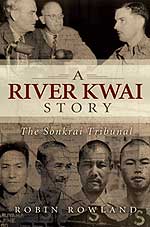Copy of a note I posted on the Far East POW list.
The Korean gonzuku guards were among the worst in the camps. And since one of the main characters in my book was the notorious Toyoyama with F Force, when I was doing the academic side of my research, I deliberately took a directed reading course in Korean studies at the University of Toronto, to get their point of view, mainly so I could understand the character.
Although I have little sympathy for these people, some facts that are not generally known
1. Most of the guards were draftees. If a local village or region did not meet quotas from either volunteers or the draft, the local community was ordered to provide more men. (This was the same system that provided "comfort women.")
2. Almost all Koreans as well as native Taiwanese (a Japanese colony at the time before post-Communist victory migration) were forced to change their names to Japanese ones if they wanted to work for the Japanese or upon being drafted or press ganged.
3. There are academic studies in Japan that indicate that the proportion of Koreans charged, tried, imprisoned or executed for war crimes against POWs was higher than the Japanese themselves largely because the Korean guards had closer contact with the POWs, so that they could be identified easier and their war crimes easily proven beyond any reasonable doubt. It has been argued-- convincingly in my view-- by Japanese academics that this was a case of concentrating on the lowest levels of responsibility while those also responsible, the mid-range of the Japanese officers in the camps or headquarters, captains, majors and colonels, often, but not always, escaped retribution from the Allies because they could not be identified and the cases against them proven.
4. The Korean guards underwent a brutal six week basic training course in Korea before being shipped to the camps. The basic training consisted largely of bashing for the most minor infraction, so that when they bashed POWs, they were doing what they had been taught to do.
5. This doesn't mean that they escape responsibility, many brought up to revere Japanese culture wanted to be more Japanese than the Japanese.
6. Most of the Korean guards convicted of war crimes were for decades and those few still surviving in a legal limbo. Because they were on "lifetime parole" they were not permitted to leave Japan after all the war criminals, Japanese and Korean, were freed in 1956. At the time Koreans were a despised minority in Japan. The gonzuku in Japan were also denied veterans benefits (while Japanese war criminals did get the benefits). Japan's argument was that since Korea was independent, Korea was responsible for them (even though they were drafted into the IJA) . So the men settled in ghettos, lived on odd jobs and some locally provided welfare or money from families in Korean and in most cases never married. They had a large suicide rate in the 50s and 60s.
7. A modern irony "gonzuku" roughly translated means civilian contractor. The gonzuku were not part of the IJA order of battle and actually signed an employment contract. The other auxiliaries, heiho, which were used in combat were part of the IJA order of battle.
Technorati tags
research, writing, journalism, Burma Thailand Railway , World War II, Thailand, Korea, Japan




